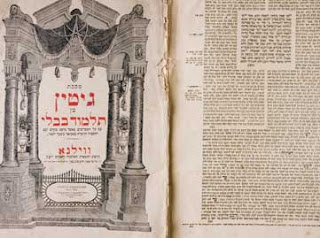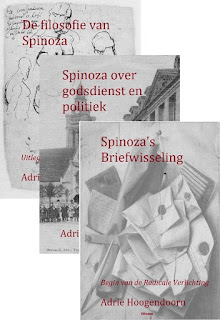Spinoza in de joodse historiografie [17] David B. Ruderman
In de maanden juni en juli had ik een flinke reeks over Spinoza in de joodse historiografie [zie in dit blog de inhoudsopgave van die reeks]. In die reeks had ik niet apart opgenomen de joodse historicus David B. Ruderman, daar ik in eerdere blogs al aandacht aan hem en zijn belangrijkste boeken had besteed, n.l.: De fundamentele fout van Spinoza...[blog] en Simone Luzzatto (1583 1663) voorafschaduwing van Spinoza? [blog]
 Nu heb ik een aanleiding om er een blog aan toe te voegen en te verwijzen naar de reeks audio-opnamen van colleges van David B. Ruderman die The Teaching Company in 2007 op de markt bracht, getiteld: Between Cross and Crescent: Jewish Civilization from Mohammed to Spinoza.
Nu heb ik een aanleiding om er een blog aan toe te voegen en te verwijzen naar de reeks audio-opnamen van colleges van David B. Ruderman die The Teaching Company in 2007 op de markt bracht, getiteld: Between Cross and Crescent: Jewish Civilization from Mohammed to Spinoza.
De uitgever over deze reeks:
"Between Cross and Crescent: Jewish Civilization from Mohammed to Spinoza presents an overview of Jewish culture and society from its rabbinic foundations in late antiquity until the dawn of modernity in the 17th century. In so doing, it places a special focus on Judaism's creative encounter with Christianity and Islam, giving us a unique perspective from which to examine the three major Western religions as they interact over time, and noting especially their ability or inability to tolerate and even appreciate the "other," as viewed from the vantage point of the Jewish minority.
 24 lectures, 30 minutes/lecture Taught by David B. Ruderman University of Pennsylvania Ph.D., Hebrew University, Jerusalem What is it like to practice your faith in an environment dominated by another? To evolve as a people when all of the world around you moves to religious and cultural rhythms very different from your own? To maintain your unity as a living community-and always to be aware of that sense of community-even when your numbers have been scattered across many lands, without a common government, a common country, or even a common language? Moreover, how might these circumstances affect not only your own history, but also the history of those other cultures through which you move? What might you take from them? For 10 formative centuries, the answers to questions like these helped define a developing Judaism, whose history was forever affected by its encounters with the surrounding social, economic, political, and intellectual environments of both medieval Islam and Christendom. As a result of those encounters, new pathways of philosophical inquiry and religious spirituality would be formed. The Hebrew language would find new ways of artistic expression. And the role of Jews in the life of the surrounding community would be changed forever, sometimes even increased, as was the paradoxical case in Italy, by the very ghettoization meant to keep them isolated.
24 lectures, 30 minutes/lecture Taught by David B. Ruderman University of Pennsylvania Ph.D., Hebrew University, Jerusalem What is it like to practice your faith in an environment dominated by another? To evolve as a people when all of the world around you moves to religious and cultural rhythms very different from your own? To maintain your unity as a living community-and always to be aware of that sense of community-even when your numbers have been scattered across many lands, without a common government, a common country, or even a common language? Moreover, how might these circumstances affect not only your own history, but also the history of those other cultures through which you move? What might you take from them? For 10 formative centuries, the answers to questions like these helped define a developing Judaism, whose history was forever affected by its encounters with the surrounding social, economic, political, and intellectual environments of both medieval Islam and Christendom. As a result of those encounters, new pathways of philosophical inquiry and religious spirituality would be formed. The Hebrew language would find new ways of artistic expression. And the role of Jews in the life of the surrounding community would be changed forever, sometimes even increased, as was the paradoxical case in Italy, by the very ghettoization meant to keep them isolated.
1 On Studying Jewish History
2 The Rabbinic Legacy prior to Islam
3 The Beginnings of Jewish Life under Islam
4 Baghdad and the Gaonic Age
5 Saadia Gaon and His World
6 The Philosophy of Saadia Gaon
7 The Rise of the Spanish Jewish Community
8 Judah ha-Levi’s Cultural Critique
9 Moses Maimonides’s Philosophy of Judaism
10 Jewish Beginnings in Christian Europe
11 The Church and the Jews prior to 1096
12 The Crusades and the Jews
13 Patterns of Jewish Culture—Rabbinic Learning
14 Patterns of Jewish Culture—Kabbalah
15 Patterns of Jewish Culture—German Pietism
16 The Medieval Jewish-Christian Debate
17 Understanding Medieval Anti-Semitism
18 Notes on the Medieval Jewish Family
19 The Decline and Expulsion of Spanish Jew
20 Italian Jewry in the Early Modern Period
21 Kabbalah and Society in 16th-Century Safed
22 Shabbetai Zevi—The Mystical Messiah
23 The Rise of Eastern European Jewry
24 The Sephardim of Amsterdam
Op die andere collegereeks van Ruderman, Jewish Intellectual History: 16th to 20th Century, waarin Spinoza tamelijk centraal staat, had ik in een al vermeld eerder blog al gewezen. Hier meer over David B. Ruderman.
De audio's worden, zoals dat tegenwoordig gaat, op vele roofsites als torrent downloadable aangeboden.* * *
Dan nu over naar de aanleiding voor dit blog: verwarring? Bedrog?Eergisteren bracht ene Rabbi Abba Perelmuter twee lange lezingen van hem op YouTube die gehouden zouden zijn op 17 en 24 mei 2006, eveneens onder de titel Between Cross and Crescent - Jewish Civilization from Mohammed to Spinoza.
Nogal misleidend die twee gelijke titels. Even dacht ik dat het om de lezingen van de historicus Ruderman ging (die dan toen nog baarddragend geweest zou zijn…). Maar hier is echt een rabbijn en niet een historicus aan het woord. Zie hoe die gedreven spreekt over de relatie tussen christendom en jodendom.
Wie was eerst met die titel? Wie is er misleidend? Want verwarrend is het.
In het tweede deel komt vanaf 1:00 uur Spinoza heel even voorbij. Gênant te merken hoe weinig Perelmuter over hem weet, hoeveel foute informatie hij geeft en hoor hoe populistisch hij over Spinoza spreekt:
“We don’t know what to do with this guy.
He was a good philosopher and he was a Jew.
How to look at this guy?”
Ik heb getwijfeld of ik de video’s wel zou binnenhalen, maar ja, het hoort wel bij het concept van dit blog: ik wil zien en doorgeven hoe over Spinoza wordt gesproken. Vandaar.
Rabbi Abba Perelmuter op 17 mei 2006
Rabbi Abba Perelmuter op 24 mei 2006

